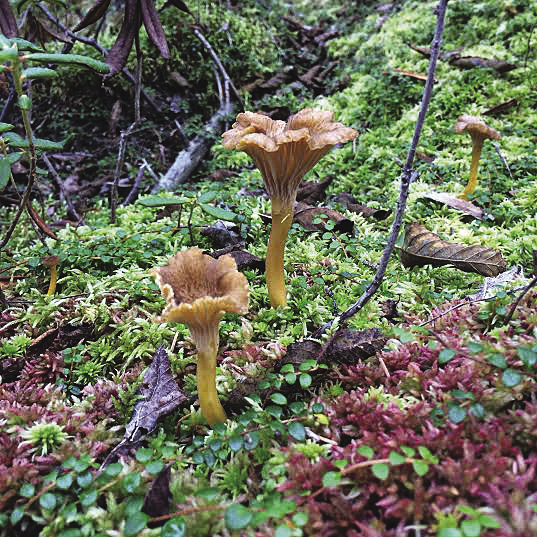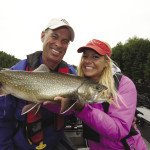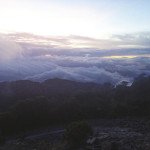When I think of chanterelle mushrooms, I’m often reminded of the golden-coloured, thick-stalked, chanterelle, a choice sought after by market buyers and culinary enthusiasts across North America. Known for its apricot fragrance and mild to peppery taste, cantharellus cibarius is one of the most popular and prized edibles in the wild world of mushrooms.
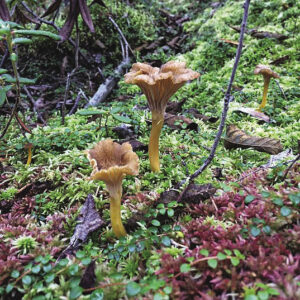
But there are other mushrooms in the chanterelle family—at least 13 known species on our continent. The majority of them are good edibles, including the yellow-footed and trumpet chanterelles. Known to avid foragers in Western Canada but generally under the radar in this region, these are two more varieties to add to your wild food palette.
“I don’t think that many people know that they exist here,” said Paul Drombolis, an avid fisherman, mushroom forager and resident of Thunder Bay.
Unlike most chanterelles that grow in dry conditions, the yellow-footed and trumpet chanterelles typically thrive in swamps and moist areas covered in sphagnum moss. Drombolis often wears rubber boots, or even hip waders if the occasion calls for it, when he’s foraging for yellow-foots, as he colloquially calls them.
“I’ll be standing in the middle of this puddle, and just picking around it,” he said.
The National Audobon Society describes the yellow-footed chanterelle as having an orange-brown to brownish cap, with a wrinkled undersurface and a descending stalk. Like many mushrooms, the caps grow downward when young, becoming vase-shaped with raised edges as they mature. Trumpet chanterelles look similar, but can take on a violet hue.
These thin-fleshed mushrooms have a high water content, so instead of going home and frying them in a pan right away, it’s best to put the mushrooms in a paper bag and leave them in the fridge for a few days to exhaust some of the moisture.
Like many foods that are produced in certain regions (think wine or cheese), the natural environment influences their taste and aroma. When it comes to wild foods, mushrooms are no different. Leave it to fact or fiction, but when Drombolis is frying up a pan of yellow-foots, he can also taste the partridge berries, sphagnum and black spruce that these mushrooms share in their habitat.
“When I eat them, it kind of just reminds me of that place,” he said.
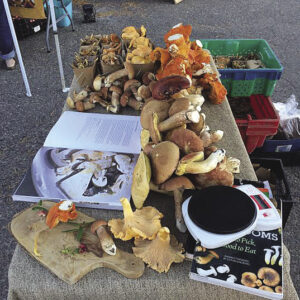
Yellow-foots and trumpets can bloom as early as July, but tend to be a late species in Northwestern Ontario, typically blooming in the fall. In forager circles, they’re sometimes referred to as winter chanterelles.
Drombolis was first inspired by mushrooms as a student at Lakehead University in Thunder Bay. During a mushroom course, his class took a full day trip through Quetico Park to explore different species.
“It was my first real exposure (to wild mushrooms). I totally fell for mushroom picking at that point,” he said.
After spending more time in the forests of Northwestern Ontario, he began noticing patterns in the natural environment. Certain habitats and conditions yielded certain results, like formulas in the mathematics of nature.
“Mushrooms really reminded me of fishing,” he explained. Much like fishing, the species and population of mushrooms are entirely dependent on the conditions of their natural surroundings.
As a beginner forager, Drombolis identified the types of trees that were growing in a given area. Now, he whittles his search down to finer details like the age of certain trees and how far they’re spaced apart.
“You can just keep digging and digging. I like figuring out that pattern—that’s what fascinates me the most. If it all comes together just right, that’s when you find a ton of mushrooms,” he said.
This summer, you may find Drombolis at the Thunder Bay Country Market, with a table of wild edibles, including chanterelle, lobster, boletes and hedgehog mushrooms. He keeps books and other educational resources on hand so people can learn about foraged food.
“I enjoy sharing the experience with
others,” he says. “And raising the environmental consciousness of what’s growing in our area.”


